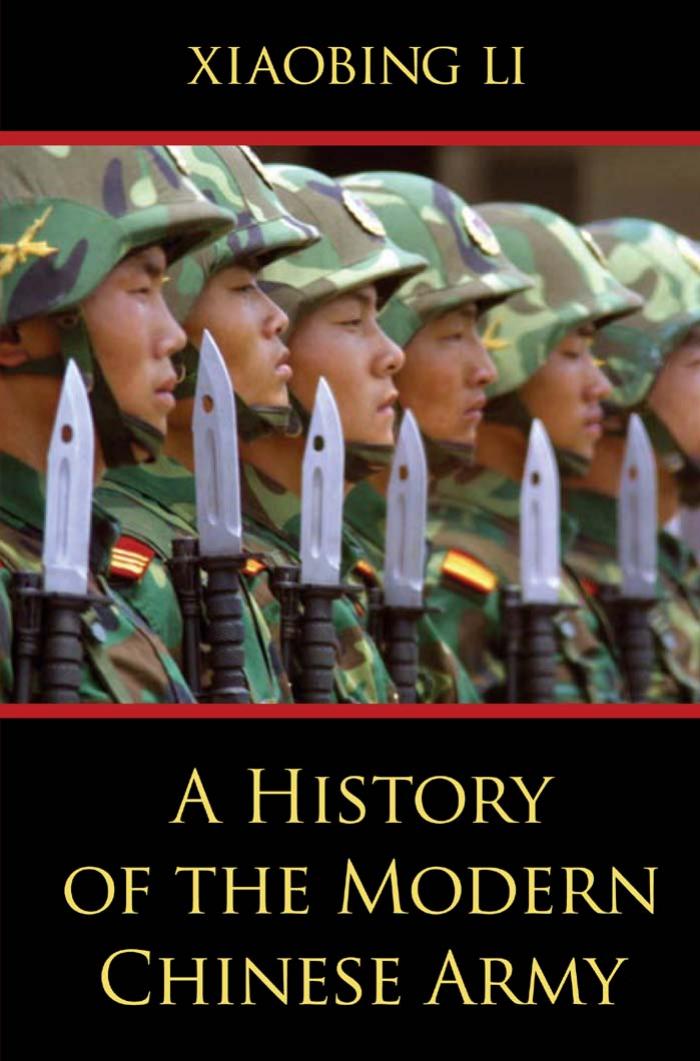A History of the Modern Chinese Army by Xiaobing Li

Author:Xiaobing Li
Language: eng
Format: mobi, epub, pdf
Tags: ISBN-13: 9780813124384, University Press of Kentucky
Published: 2014-03-02T16:36:56.759000+00:00
Border Conflicts and the Cultural Revolution 0
thing about this new appointment, Wei studied international relations,
diplomacy, and the new republic’s foreign policy in Beijing.17
Shortly after accepting his new appointment, Wei submitted his
plan to the high command. On April 17, the CMC ordered its Sec-
ond, Third, and Fourth field armies to select experienced officers to
organize the CMAG. In May, 281 officers reported to the CMAG, in-
cluding 59 commanders and officers at the battalion level or above. On
June 27, two days after the Korean War broke out, Mao, Zhu, and Liu
met with Wei, Mei Jiasheng, Deng Yifan, and other high-ranking advi-
sors at Zhongnanhai. Mao told the military advisors that he was not the
one sending them to Vietnam. “It is President Ho Chi Minh who has
asked me for [your assistance],” the chairman said. “Who would have
thought our revolution would succeed first? We should help them. It
is called internationalism. You will help them to win the battles after
you get to Vietnam.”18 Liu and Zhu also spoke at the meeting. In July,
the CMC approved a party committee of the CMAG with Wei as the
secretary and Deng Yifan as the deputy secretary. At the CMAG head-
Ho Chi Minh and Vo Nguyen Giap meet with Chen Geng and Luo Guibo
in Vietnam in 1950. (Courtesy of Colonel Yan Guitang, member of the
CMAG.)
0 A History of the Modern Chinese Army
quarters, political, operational, technical, and medical advisory teams
were organized.19
On July 7, Senior General Chen Geng joined the CMAG as the
CCP Central Committee’s representative and entered Vietnam. Born
in Hunan in 1903, Chen joined the CCP in 1922 and enrolled in
the Huangpu Military Academy in 1924. He studied military science
in the Soviet Union in 1926. After his return, he became a battalion
commander and participated in the 1927 Nanchang Uprising. Then
he served as regiment and division commander of the Red Army. Dur-
ing WWII, Chen became the commander of the 386th Brigade, 129th
Division, Eighth Route Army. During the Chinese civil war, he was
appointed commander and political commissar of the Fourth Army
Group. After the founding of the PRC, he became the commander of
the Yunnan Military District and governor of Yunnan Province. Senior
General Chen was one of the most experienced and dedicated generals
of the PLA. In his telegrams to Chen in June 1950, Liu Shaoqi autho-
rized Chen as the “representative of the CCP Central Committee” in
charge of military advice in Vietnam.20
On August 11, Wei led the CMAG, about 250 officers, accom-
panied by Hoang Van Hoan, the Vietnamese ambassador to China,
into Vietnam. The next day, the PAVN held a welcome meeting, and
General Giap, commander in chief of the PAVN, made a speech in
Chinese. After their arrival, Wei, Chen, Mei, and top advisors served at
PAVN headquarters, including in the General Staff Department and
the Bureaus of Political Affairs and General Logistics. The other advi-
sors served at the headquarters of the 304th and 308th divisions and at
the headquarters of the 148th, 174th, and 209th regiments, according
to their rank and expertise. Zhai argues that personality was “an impor-
tant factor in shaping Beijing’s attitude toward revolution in Vietnam.”
The CCP and PLA leaders did not ignore “the close personal ties and
revolutionary solidarity that they and Ho Chi Minh had forged in the
years of common struggle in the past.
Download
A History of the Modern Chinese Army by Xiaobing Li.epub
A History of the Modern Chinese Army by Xiaobing Li.pdf
This site does not store any files on its server. We only index and link to content provided by other sites. Please contact the content providers to delete copyright contents if any and email us, we'll remove relevant links or contents immediately.
| African-American Studies | Asian American Studies |
| Disabled | Ethnic Studies |
| Hispanic American Studies | LGBT |
| Minority Studies | Native American Studies |
Cecilia; Or, Memoirs of an Heiress — Volume 1 by Fanny Burney(32440)
Cecilia; Or, Memoirs of an Heiress — Volume 2 by Fanny Burney(31875)
Cecilia; Or, Memoirs of an Heiress — Volume 3 by Fanny Burney(31858)
The Great Music City by Andrea Baker(31539)
We're Going to Need More Wine by Gabrielle Union(18973)
All the Missing Girls by Megan Miranda(15598)
Pimp by Iceberg Slim(14399)
Bombshells: Glamour Girls of a Lifetime by Sullivan Steve(13979)
Talking to Strangers by Malcolm Gladwell(13233)
Norse Mythology by Gaiman Neil(13216)
Fifty Shades Freed by E L James(13163)
For the Love of Europe by Rick Steves(13116)
Mindhunter: Inside the FBI's Elite Serial Crime Unit by John E. Douglas & Mark Olshaker(9209)
Crazy Rich Asians by Kevin Kwan(9173)
The Lost Art of Listening by Michael P. Nichols(7412)
Enlightenment Now: The Case for Reason, Science, Humanism, and Progress by Steven Pinker(7242)
The Four Agreements by Don Miguel Ruiz(6641)
Bad Blood by John Carreyrou(6558)
Weapons of Math Destruction by Cathy O'Neil(6152)
